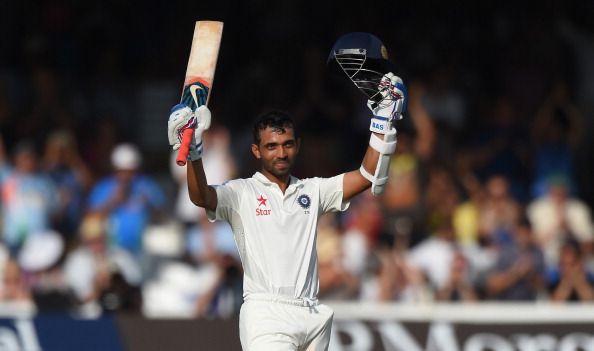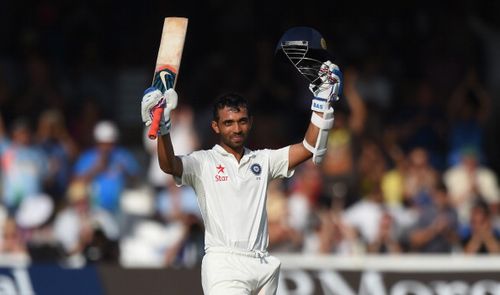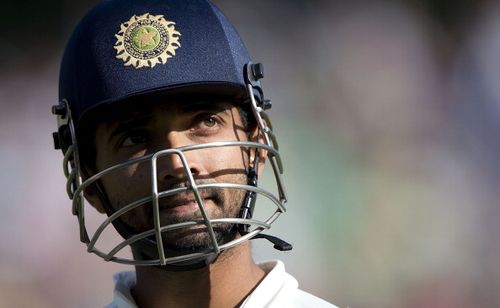
The rise of Ajinkya Rahane

Wellington. Lord’s. Melbourne. What can these three cricket grounds have in common? Maybe, the fact that these and Nottingham are the only four venues where India didn’t lose a Test match in 2014. India won the second and managed a draw in the first and third. But, most importantly, they share the fact that the honours boards’ of these stadiums have Ajinkya Rahane’s name on them.
Yes, three of the four matches that India managed to save their face this year have Rahane’s contributions. His teammates affectionately call him ‘Jinks’, but he has proved that he is everything but a jinx.
How not to make your debut
Ajinkya Madhukar Rahane’s story is one of grit and determination: the determination to make it big in a nation where every boy’s first dream is to play cricket for his country, and the grit to actually do it. He was named in the Test squad in November 2011 for the series against West Indies, but had to wait for 16 months before actually getting a game in March 2013 against Australia. His debut also ended Mumbai’s dry run of not having given India a Test player since 2007.
But this wasn’t a debut Rahane or, for that matter, anyone would want to remember. He was only the third choice to fill in the vacancy created by Virender Sehwag, but Shikhar Dhawan’s injury and Gautam Gambhir’s illness meant he was handed his first opportunity – only for him to score 7 and 1 in the two innings that he played.
More than the lack of runs, the manner in which he got out in the second innings – an ugly swipe unmindful of the match situation – led to his exclusion from the 15-man squad for the West Indies series that followed, where his flamboyant Mumbai teammate Rohit Sharma had a dream debut making 177 runs.
Fruitful second coming
His chance would come later, against South Africa, following the retirement of Sachin Tendulkar. And he made that opportunity count with a 47 in Johannesburg and another twin fifties in Durban against Steyn and Co. He later said: “That’s when I felt that I can handle any bowling attack in the world.”
His best, however, was yet to come. India were reeling at 165-5 when Rahane took the field and scored 118, his maiden Test century, taking the team’s total to 438. This innings was the omen of the things to come.
At Lord’s, Rahane came to bat when India were 86-3 and continued batting till he was caught and bowled by James Anderson on 103. The team total was 275 now. Ishant Sharma and Mohammed Shami would add another 20 runs to take India to 295. In an innings where his teammates were falling like nine pins and the next highest score was 36, by Bhuvneshwar Kumar, Rahane stood tall like the fighter he is. He followed this up with twin fifties at Southampton.
Scoring runs must be second nature for a guy who said this in an interview “When I bat, I take the responsibility of the entire team on me. I owe it to every member of the team including the support staff for the hard work they put into preparing me for the match. It is also my responsibility to bat for those team \mates of mine who are not doing well.” Clearly, he walks the talk.

In the ongoing Border-Gavaskar trophy, he made 62 and 81 at Adelaide and Brisbane before registering a career-best 147 in Melbourne. This inning was also true to his character; when Virat Kohli wasn’t content with letting just his bat do the talking, Rahane went on scoring runs with a zen-like focus. But, then, indomitable spirit is one of the virtues of a black belt holder. Yes, Rahane is a black belt holder.
Rahane used to travel for four hours in local trains from Dombivali to CST with a cricket kit bag. He confesses “If you got out early, it would hurt a lot. I used to get very upset because I couldn't play for long after coming from so far for the match.”
Nearly two years after making a disastrous debut in the whites, Rahane has, now, become a permanent fixture. So important that he is in the contention to be India’s next vice-captain after MS Dhoni’s sudden retirement. On the other hand, Rohit, his extravagant Mumbai teammate with a dream debut, is yet to establish himself in the team.
A hero that an average Indian fan can look up to and emulate
Simon Barnes, the author of A Book of Heroes, wrote: “You might say that the provision of heroes is the basic point of a sport. If a sport doesn’t provide heroes, it wouldn’t command our imaginations.” Truer words have never been said.
We need someone to look up to, to live that life we imagined for ourselves. And the tale of a middle-class guy making his presence felt in the international circuit is the kind of story an average Indian fan can relate to.
He is the guy who dreams of owning an Aston Martin and Lamborghini some day. But, meanwhile, he wants to do everything possible for his parents and siblings. He can’t forget the sacrifices his mother did for him, holding his brother and walking for 2 kms to the practice ground and waiting for 3 hours with the young kid in tow. These are the shackles most Indians are trying to break, and seeing one amongst us succeed gives us great pleasure.
Few years down the lane, the Wellington Test will be remembered for Brendon McCullum’s triple century, the Lord’s Test for the legend of Ishant Sharma and the MCG Test for the beginning of Kohli-Mitchell Johnson saga. For India, however, these will be the matches in which she discovered a new “Wall”. Only a lucky few can pay homage to their mentor by becoming his replacement in the team. Ajinkya Madhukar Rahane is one of them.